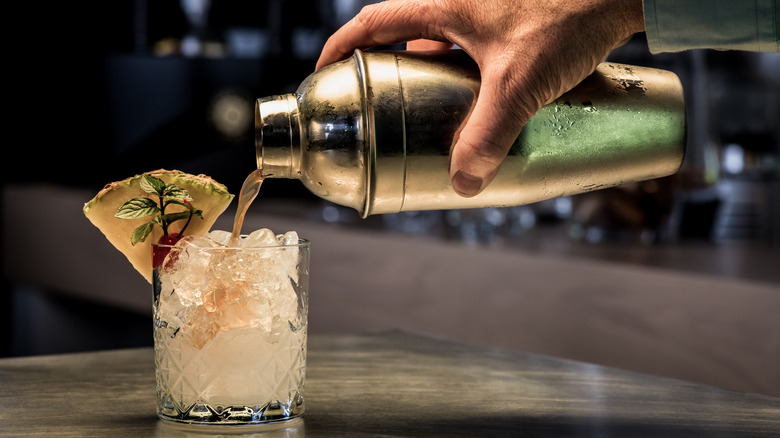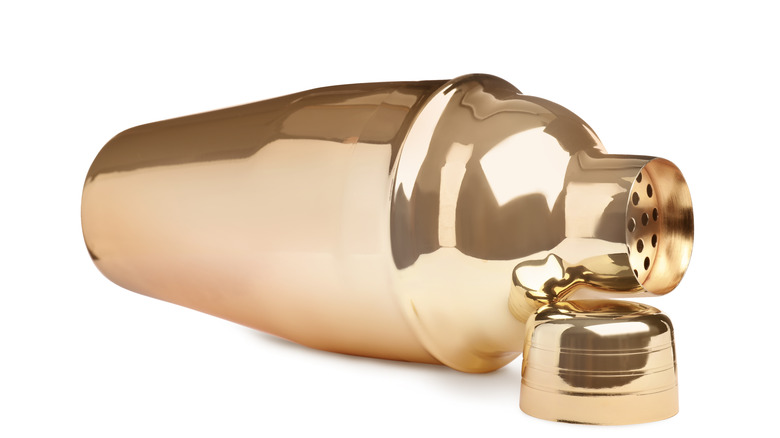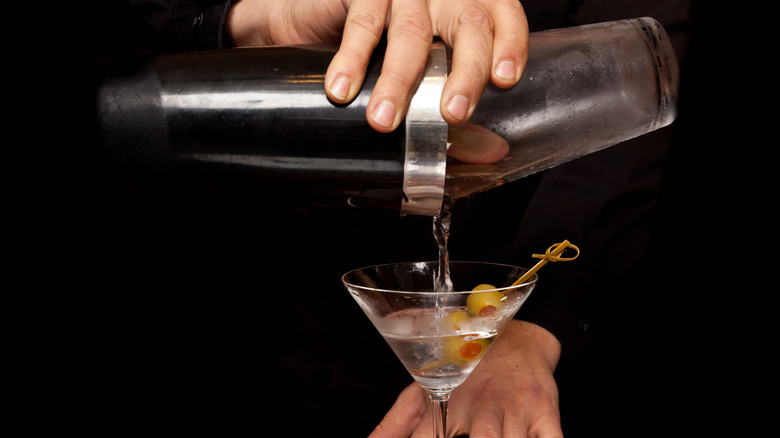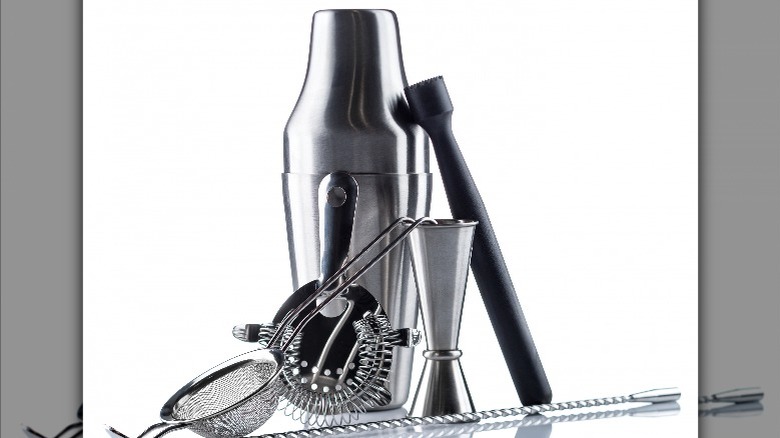The 3 Types Of Cocktail Shakers You Should Know Before Making A Drink
No contraption in mixology is more indispensable than the cocktail shaker. There's a captivating allure to the sight and sound of a bartender putting one into action — a signal that a tasty cocktail is coming together, and is about to flow into the glass. And while the maneuver is straightforward in nature, the utilized shaker makes a difference in your drink. There are three types to choose from: the Boston, the Cobbler, and the French, also known as a Parisian. While a selection won't necessarily limit your cocktail possibilities, they do all come with a unique set of pros and cons.
The Boston shaker is the oldest of the trio, around since at least 1848. It consists of only two parts: a large 28-ounce shaker, and a smaller glass-based 16-ounce insert. The most popular choice in commercial settings, it requires a learned technique of sealing and opening, making it less favored for novices. The Boston later evolved into the easier-to-use Parisian shaker. Also consisting of two components, in this variation they're both made of tin. While the seal is less tight, the design is super sleek, making it a stunner to use, and easy to clean.
Finally, there's the Cobbler, the newest of the styles. The most popular in a domestic realm, it's easy to figure out and comes with a strainer, too. For those just getting into mixology, it's the most obvious choice, but that doesn't mean it's always the best.
For all-in-one accessibility, purchase a Cobbler shaker
The classic Cobbler is likely the shaker you already have at home. It consists of three parts: a metal cap, which doubles as a 1 ounce jigger, a tin container, and a lid with built-in holes for straining. Crafting a cocktail in a Cobbler is as easy as it gets — simply measure components into the tin vessel filled with ice, shake for a quick five to seven seconds, and strain through the top.
The device came about in 1884, and its name is derived from a drink called the Sherry Cobbler. Made with berries, sherry, and plenty of ice, this cocktail showcases the Cobbler's strong suit. It is predisposed to cooling elements with ice of any size, and then straining the mixture through the holes. However, this attribute can also be a downside, as sometimes a finer sieve is necessary. Such a quality makes this shaker less ideal for a martini or a cosmopolitan — drinks you wouldn't want to contain any ice chips. The Cobbler is also a little too clunky for egg-white cocktails, like an amaretto sour, since it won't trap egg white impurities.
Nevertheless, the Cobbler will produce a near-perfect version of most cocktails, including stirred drinks. It might have a small hindrance like a stuck lid when it gets especially cold, but it'll dependably get the job done.
Turn to the Boston shaker for an industry favorite
The two-piece Boston shaker takes a bit of practice to nail down. First, stacking the upside down glass onto the tin container may not feel intuitive since it requires a gentle press or tap. However, the two containers will form a tight seal that only strengthens once shaken. This comes as an advantage, since it prevents any accidental spillage or lids flying off during mixing. After the shakes, the Boston is tricky to open as well; it's necessary to tap or squeeze the larger of the two containers to disjoin them.
After a few go-rounds, the process smooths out, and the shaker's advantages become evident. Its simple design makes it quick to clean and swiftly prep for the next concoction. The interior is spacious, with a larger volume than the Cobbler, meaning extra room to mesh the components together. Plus, the integration of more air into drinks lends to a better mouthfeel, and creates the best egg white foams in slings like a whiskey sour.
The Boston shaker doesn't come with a strainer. Sure, that means another purchase, but also more malleability when it comes to the sieve. Most commonly, it gets paired with the Hawthorne strainer, suitable for the majority of drinks. And such is the shaker's greatest benefit — with a bit of skill, it'll create just about any cocktail.
A Parisian shaker offers mixing with a flair
Then there's the French, or Parisian, shaker. A hybrid between the two aforementioned styles, it's undoubtedly the sleekest in terms of looks, with an eye-catching curved shape. Like the Cobbler, the Parisian is exclusively made from metal, and like the Boston, it's comprised of only two pieces. The smaller cup on top is where the liquids are stirred, and the larger one on the bottom is where they're shaken.
The seal will be less secure than the others, making it more prone to accidents. When attempting to impress with extra vigorous movement, hold tight to make sure the lid doesn't fly off. On the plus side, this also makes it easier to open and close. And there's no risk of any glass shattering, since it's all metal. Such a sturdy quality makes it extra durable when muddling is involved, like in a Caipirinha.
The average volume sits at 24 ounces, slightly smaller than the average Boston, which creates a little less aeration. Unlike the Cobbler, the Parisian doesn't have a strainer, so sieve away with the side piece of your choosing. Nevertheless, it's a fashionable choice popular in Europe, so use it to readily shake cocktails into the night.



